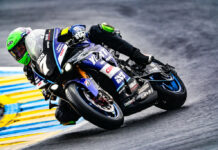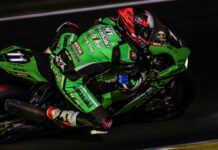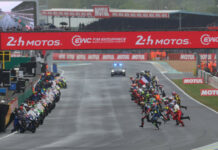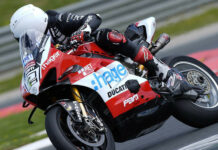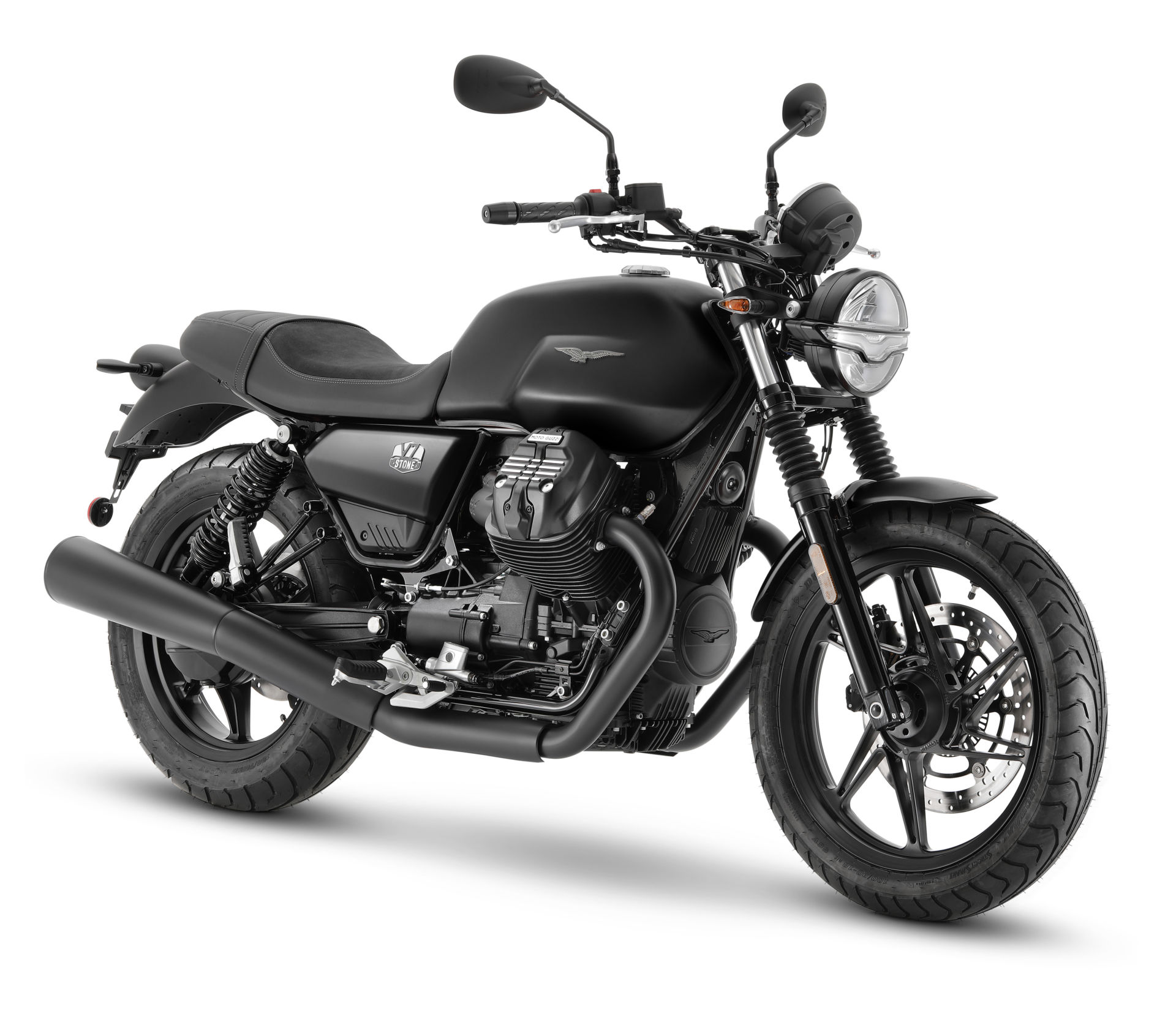NEW MOTO GUZZI V7
IN MOTO GUZZI’S ONE HUNDRED YEARS OF LIFE, THE V7 IS ONE OF THE MOST BELOVED AND SUCCESSFUL MODELS, RECOGNISED ALL OVER THE WORLD AS A REPRESENTATIVE OF THE CLASSIC ITALIAN MOTORCYCLE
MOTO GUZZI PRESENTS A COMPLETELY REVAMPED V7. THE NEW, HIGH-PERFORMANCE, 850CC, 65 HP ENGINE MAKES ITS DÉBUT. V7 IS FASTER, MORE COMFORTABLE, BETTER EQUIPPED AND MORE REFINED, WITHOUT LOSING ANY OF THAT CHARACTER AND AUTHENTICITY THAT HAS ALWAYS DISTINGUISHED EVERY MOTO GUZZI
V7 is one of the most celebrated and well-known Moto Guzzi models. This global fame is due to its ability to remain faithful to the expectations and reputation of a legendary brand like Moto Guzzi. Since 1967, the year the first units were sold in Italy, the V7 has become a cornerstone of the product range, representative of the ultimate Italian motorcycle and standing out for its content and design, highly popular with a wide and varied public.
More than fifty years after the launch of the first unit, Moto Guzzi is proud to present the new V7, the most recent chapter of a unique history. The revamping is so profound that Moto Guzzi opted to change the name too: V7, without the progressive numbering with Roman numerals that had characterised the previous models – a testament to the almost total change from every point of view, even involving the chassis architecture and the engine. You wouldn’t think so at first glance, and that is perhaps the highest compliment that could be paid the eagle brand designers and engineers in Mandello who have once again demonstrated their passion and skill in improving a legendary model like the V7, leaving its character and authenticity unaltered, values destined to last over time. Two versions are available: alongside the Stone, the most minimalist model with modern content, is the Special which, as always, remains the most classic and elegant.
More maturity, performance and comfort: V7 is a pleasure to own and to ride
The new generation V7 will continue to be the entry-level motorcycle of the Moto Guzzi world, easy to ride, with a contained size and weight, but at the same time with a strong and authentic character, typical of all Moto Guzzi bikes, much of which is shown off by the transversal V-twin engine, a one-of-a-kind configuration. The newborn from Mandello is more complete and demonstrates superior maturity, evident in the new, larger engine, which stands out for its generously sized exhaust pipes in a different layout; the view from the rear also highlights the larger cardan final drive and the wider rear wheel, as well as the larger and robust pair of Kayaba shock absorbers. The new V7 therefore has many new features, not only technical, but also philosophical. From now on, we’ll be able to talk about the “eight-fifty” from Mandello, and it is the first time this model adopts this engine size, since it has been a 750 cc since 2009. This is a quantum shift in terms of performance and riding fun, and it is probably the highest performance and most efficient engine ever mounted in the illustrious history of this model.
Authentic style and modern content
V7 keeps the stylistic personality of the model intact, characterised by a design that dialogues through shapes influenced by Moto Guzzi heritage and modern motorcycle requirements. What hasn’t changed is the 21-litre metal fuel tank, the most spacious in the category, with style inspired, as always, by the one on the magnificent 1971 V7 Sport.
Some stylish new elements are the side panels and the shorter rear mudguard which, along with the newly designed exhaust system, give the new V7 a seductive look. One of the important innovations on the V7 Stone consists of the sporty aluminium wheel rims; the rear is shod with a larger tyre to the tune of 150/70, capable of providing greater riding stability and more grip in turns. The tyre type is different as well: in order to guarantee fun, comfort and safety in the wet, high performance Dunlop Arrowmax Streetsmart tyres were chosen. On the new V7 Stone and V7 Special, riding comfort is even greater than the already high level of the previous version, thanks to the new pair of shock absorbers with longer stroke and the new, split-level seat, which especially ensures the passenger a more comfortable ride: in fact, the taller height of the cushion means that the pillion rider’s legs are not as bent and it also offers more comfortable seating. With this same goal in mind, brand new rider footpeg vibration-damping supports are used.
Making its début on the Moto Guzzi V7 Stone is the new full LED lighting system, from the headlamp with DRL that traces the outline of the Moto Guzzi eagle. The new instrument cluster is in keeping with the minimalist motorcycle image. It is a single circular dial, entirely digital, which is also shaped like the outline of the eagle. The instrumentation is complete in terms of information, including an odometer, partial and daily trip (resets automatically eight hours after being switched off), trip time, instantaneous and average consumption, air temperature, average speed and the MGCT (traction control) level, as well as the engaged gear indicator, for which the minimum and maximum rpm value can be adjusted by the user. This way, you can control a predetermined engine rpm range, to run in the bike as effectively as possible or to reduce fuel consumption to a minimum for example. The rider interacts with the instrumentation using the button on the right-hand electrical block. The gear indicator is suggested by the outline of the eagle that flashes at the centre of the display. The catalogue of dedicated accessories also includes Moto Guzzi MIA, the Moto Guzzi multimedia platform that connects your smartphone to the vehicle, providing an exceptional quantity of information handy for your trip. Moto Guzzi MIA can be used to play music and to make/receive phone calls using a helmet intercom.
Quality chassis architecture for an easy and fun ride
Moto Guzzi is renowned for its ability to design exceptional chassis. The delightful ride of the V7 has its origins in the distant past: in 1970, after a highly demanding series of tests, the V7 Police won the selection to join the LAPD (Los Angeles Police Department) team, demonstrating the Larian brand’s authority on the matter even overseas. The steel frame maintains the double cradle tubular layout and the same weight distribution typical of this model’s recent tradition. The new V7 introduces more changes that improve stability and comfort, leaving its proverbial agility unaltered. In the area beneath the headstock, a sheet of reinforcing steel has been added, whereas the reinforcement that corresponds with the adjustable shock absorber connections has been modified. The shocks themselves are mounted in a more forward-inclined position and they are larger and have a longer stroke. The modifications to the rear suspension significantly increase riding comfort, especially on bumpy surfaces, due to the greater capacity to absorb the imperfections of the road, returning a more progressive and controlled response in any situation, even with a passenger on board. To complete the revamped chassis architecture, a new, larger swingarm is employed, featuring a new bevel gear capable of better managing the increased torque of the new engine. The already optimum saddle-handlebar-footpeg triangulation remains unchanged, ideally spaced for riders of any height thanks to the lower saddle and the correct positioning of the aluminium footpegs.
Higher performance and more character from the new Moto Guzzi “eight-fifty”
There are many twin-cylinder engines in the world, but there is only one transverse V, and it is the Moto Guzzi twin, born in 1967 thanks to the ingenious intuition of Giulio Cesare Carcano and characterised by a unique cylinder configuration that made it an integral part of the bike’s design, like a true modern art sculpture.
A new Moto Guzzi engine makes its début on the V7, a close derivative of the one that successfully powers the V85 TT “All Terrain”. This is the most recent and modern drive developed by Moto Guzzi, which guarantees better performance and overall greater efficiency in order to provide maximum riding pleasure, fun and reliability. The engine maintains the exclusive construction layout of all Moto Guzzi bikes currently in production: air-cooled transverse 90° V-twin with OHV distribution and two valves per cylinder, the pride and tradition of Mandello production. Engine capacity is 853 cc, thanks to a bore to stroke ratio of 84 x 77 mm. Compared with the “seven-fifty” in the V7 III, maximum power increases 25%, going from the previous 52 HP at 6200 rpm to the current 65 HP at 6800 rpm. Maximum torque has also increased, going from 60 Nm at 4250 rpm to an outstanding 73 Nm at 5000 rpm, with more than 80% of the torque already available at 3000 rpm. The new “eight-fifty” has more elastic pickup at low rpm and accelerates faster with an extremely low vibration rate. Once again, a reduced-power version is available, in line with the limitations set by the A2 class driver’s license and ideal for new Guzzi riders, who can also count on a contained total weight and size and the general ease of riding ensured by all V7 III versions.
The engine is entirely new compared with the V7 III: the more rigid crankcase is the result of a new design; Lubrication involves a semi dry sump, with two coaxial pumps (one for oil delivery and the other for oil recovery) that ensure excellent lubrication and dispense with the need for an oil radiator. The semi dry sump solution has all the advantages of dry sump engines, without the disadvantage of the encumbrance of the external oil reservoir, since sump itself carries out this function. The primary advantages are: less loss of power because of friction due to the interaction of the crank drive with the oil, lower maximum temperature reached by the oil and freedom of the bike to reach a greater lean or pitch angle without any lubrication problems, thereby allowing the reduction of the quantity of lubricant needed to ensure that the pump has correct draft in any situation. in keeping with Moto Guzzi identity, OHV distribution with two valves per cylinder (made of steel) is retained, though the system and materials used are all new. Cylinders are of reduced height, while efficient oil passages and a fastening system to the reinforced crankcase ensure robustness and reliability. The heads have dedicated mix entry ducts and links. One of the stand-out aspects of a Moto Guzzi engine is its distribution, complete with aluminium roller cams and rocker arm pushrods. Furthermore, lightweight pistons are used, with 20 mm diameter pins. Engine control relies on a single Marelli throttle body, 38 mm in diameter, with a traditional mechanical throttle control. The new Moto Guzzi engine is also rather frugal in terms of consumption: it has few components that absorb power (OHV distribution is one of the most frugal in terms of power absorption) and has no cooling circuit pump or long drive chains or belts. So, not only is it more powerful and cleaner than the engine in the previous V7, but it also consumes less, resulting in a range of more than 400 km after filling up, thanks to the 21-litre fuel tank.
The front-engaging gearbox was also revamped compared with the previous unit and is now more fluid and precise. the dry clutch exploits a reinforcement disc under the clutch plate as well as a high performance clutch disc; there is also a brand new, triple slot type of synchronisation that reduces gear noise and gearbox play to a minimum, particularly that of first gear. The final transmission is carried out by a double-jointed drive shaft offset by the generous size and the bevel gear, which provides solid and reliable management of the powerful torque supplied by the twin engine.
ABS and MGCT for active safety
Standard on the V7 are the ABS system and an adjustable MGCT (Moto Guzzi Traction Control) system that can also be disabled. The former is a two-channel Continental system that prevents the wheels from locking up, whereas the latter is a system that prevents rear wheel spin in acceleration. The MGCT system is adjustable to two sensitivity levels, one more conservative and ideal, for example, in poor grip situations due to wet or slippery asphalt and the other is designed to cater to the thrill of riding in safety on dry roads. Another peculiarity of the MGCT system is the possibility to recalibrate rear tyre circumference, compensating for any wear or the use of a tyre with a different profile than the original so that the traction control will always be precise.
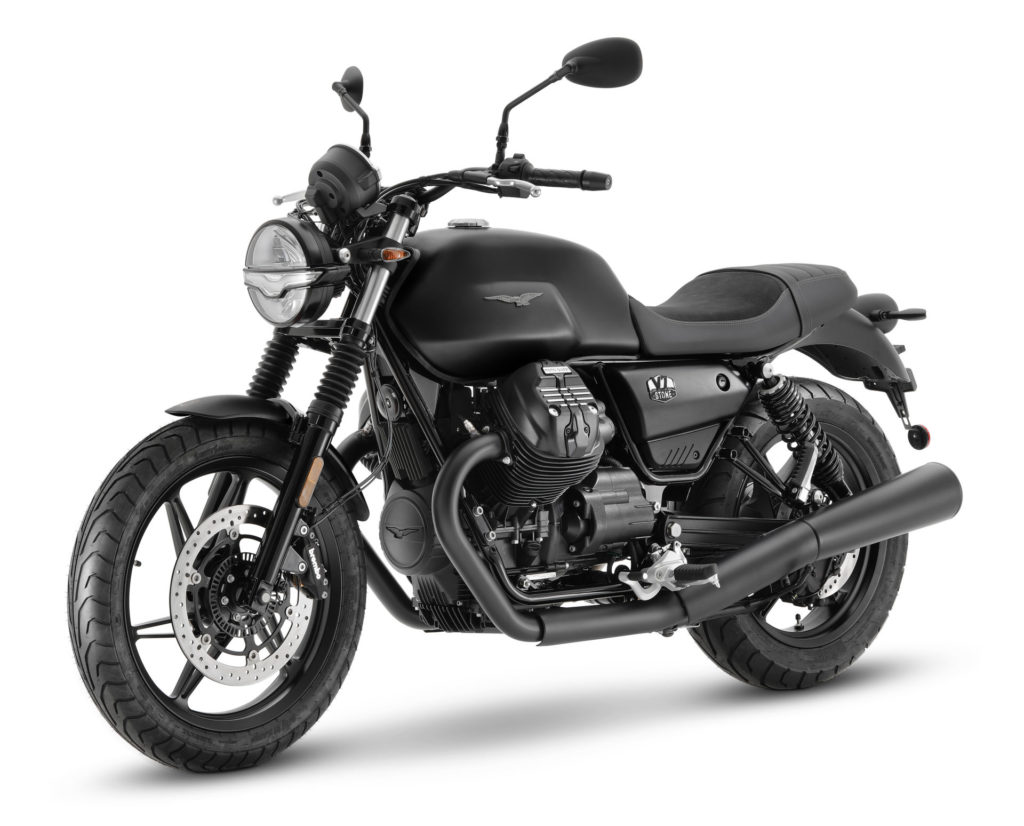
Moto Guzzi V7 Stone
V7 Stone is the most eclectic and minimalist version of the “eight-fifty” from Mandello. In keeping with recent tradition, it has no chromed parts, instead embracing the darkness of the matt black paint, which is combined with the new saddle with a passenger grab strap. It stands out both for its new full LED light system, featuring a beautiful headlamp with DRL that outlines the shape of the Moto Guzzi eagle, and for its new instrument cluster, a single circular dial, entirely digital, which is also shaped like the outline of the eagle. The wheel rims are in aluminium with six spokes, and the logo that decorates the side panels is also new.
In addition to the Nero Ruvido colour scheme, V7 Stone is available in two new, attractive satin-finish colours, Azzurro Ghiaccio and Arancione Rame, also joined by the special Centenario graphic, commemorative of the Larian brand’s first one hundred years, born in 1921. The new graphic version is a tribute to the magnificent Otto Cilindri, one of the most sensational racing motorcycles of all time, born in 1955 and even today a prime example of Moto Guzzi’s creative and technical skills. It stands out with its exclusive matt livery comprising the grey fuel tank and brown seat, combined with a magnificent green shade for the side panels and the front mudguard. Also contributing to make this look unique is the special gold colour of the eagle on the fuel tank and the name on the side panels.
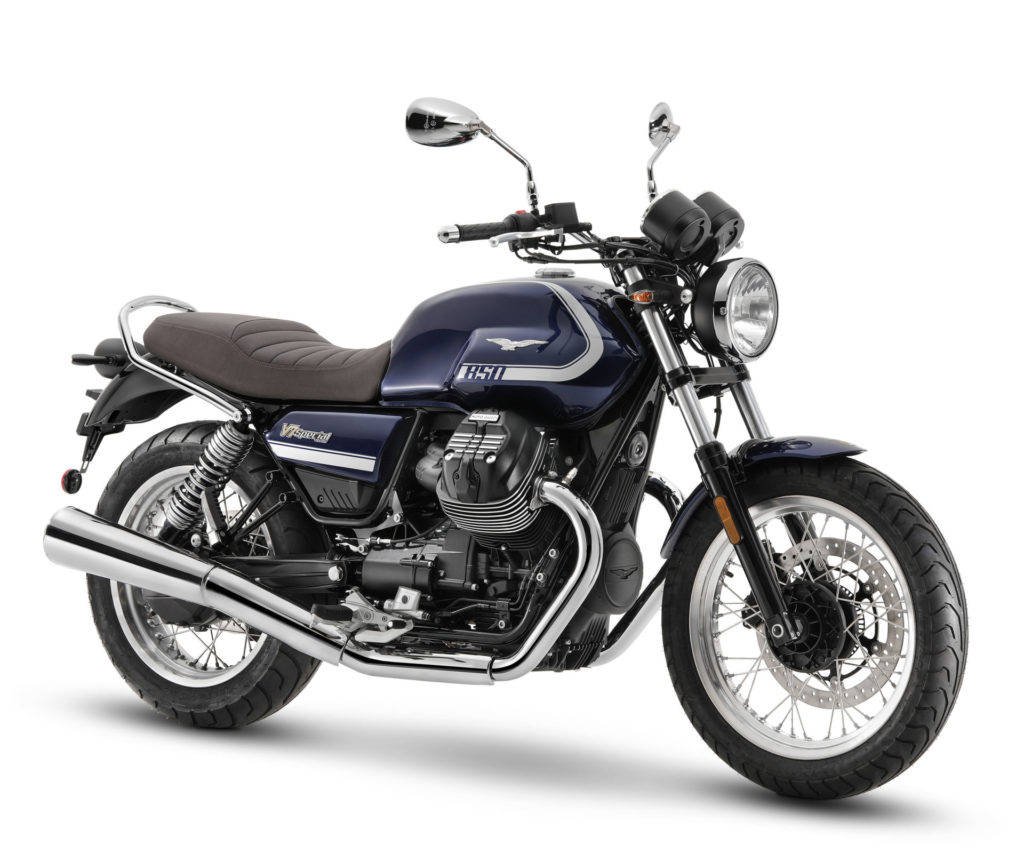
Moto Guzzi V7 Special
This version is the closest to the spirit of the original model. Classic and elegant, it features numerous chrome parts and decidedly bright graphics. Moto Guzzi V7 Special flaunts a new interpretation of the typical coloured stripe on the side panels beneath the seat, which is colour-coded to match the colour of the fuel tank. The spoked wheels have polished channels and black hubs; the analogue instrumentation is made up of dual circular displays and the new chromium plated steel passenger grab handle comes standard. The lighting system includes LED turn signals and taillight unit, whereas the classic halogen headlamp remains unchanged. V7 Special also has cylinder cooling fins milled on a machine tool and a dedicated brown saddle, details that highlight its classical and elegant origins. It is available in the Blu Formale and Grigio Casual colour schemes.
Moto Guzzi MIA: a proper on board computer
For the V7 range, the innovative Moto Guzzi MIA multimedia system is available as an optional accessory. This system is able to connect the bike to a smartphone. Thanks to a dedicated application, which can be freely downloaded from the App Store and Google Play, the smartphone (iPhone or Android) becomes a truly sophisticated on-board multifunctional computer, the link between the vehicle and the Internet.
The Bluetooth connection allows you to simultaneously view five parameters of your choice at a time on your smartphone screen, selected from a vast menu and including the speedometer, rev counter, instant power, instant torque, instant and average fuel consumption, average speed and battery voltage, longitudinal acceleration and extended trip computer. The “Eco Ride” feature helps to limit fuel consumption and to maintain eco-compatible riding conduct, providing a brief assessment of the results obtained during the trip. You can record trip information and review it on your computer or directly on your smartphone, analysing the route taken, viewing the vehicle operating parameters point by point. The system also allows you to easily locate your vehicle when you park in an unfamiliar place, automatically saving the position where it was switched off.
V7 Stone’s digital instrumentation integrates fully with Moto Guzzi MIA, so you can manage your smartphone’s multimedia content, as well as telephone calls. The titles of the musical tracks and caller ID appear on the instrumentation display and you can manage all interaction using the handlebar controls, which include activating the telephone’s voice assistant.
The sophisticated on board module management also lets you use two common Bluetooth headsets to achieve the interphone feature, without the additional cost of a dedicated system.
Original Moto Guzzi accessories: a comprehensive range for every possible need
Following the success achieved on the previous versions, the Moto Guzzi customisation philosophy continues on the new V7 as well. This means that there are numerous accessories available so that you can personalise your motorcycle in a fun and safe way, creating a true made to measure special. All of the parts have been conceived, designed and made by Moto Guzzi and they are subjected to strict control test cycles just like any other original part on the bike in order to guarantee a quality and long-lasting product. Since they have been conceived and fine tuned by Moto Guzzi they are perfectly interchangeable with the factory parts, allowing you to easily revert your bike to its original configuration. They are also fully approved and therefore absolutely “street legal”.
Below are a few of the main accessories in the catalogue dedicated to the V7 range.
Red cylinder head covers: cylinder head covers painted red with special, machined patterns.
Tubular engine guard: characterised by a design that follows the lines of the vehicle, this provides specific protection for the engine and the rider’s legs. Available in chromium or black.
Fuel tank cover: these are two soft rubbery guards that are applied to the sides of the fuel tank where the rider’s knees rest in order to increase riding comfort.
Centre stand: made out of robust materials, this lets you park your bike in complete safety.
Sport handlebar and semi handlebars: these let you assume a more forward and sporty riding position.
Windshield: this is designed to provide greater aerodynamic protection without compromising the attractive aesthetics of the V7. Type-approved for the strictest standards (DOT and TUV), it has been road tested in all weather conditions by Moto Guzzi test riders. Available in two versions with chromium or black rods.
Aluminium brake and clutch levers: made of billet aluminium with a stylish design, they enhance the V7’s controls.
Heated hand grips: these are adjustable to different intensity levels, so you can ride your bike even in the coldest seasons.
Side panniers in leather, canvas and touring: thanks to the frames featuring fast click quick release, you can use various types of side panniers on the V7. The Moto Guzzi range of accessories includes a pair of panniers in precious, hand crafted leather with closing and buckles in steel and hot-branded with the Moto Guzzi logo, a pair of Touring panniers in sturdy technical fabric to withstand any travel conditions and a pair of very spacious and elegant waterproof Canvas panniers. A special anti-theft locking system prevents any undesired fast click quick release.
Luggage carrier: this valuable item serves two important purposes: on one hand it is a luggage rack and on the other it provides a solid hold thanks to the two built-in handles.
Saddles range: the range of Moto Guzzi saddles for the V7 includes 6 versions and variations to meet any and all comfort and design needs. All the saddles are fully waterproof, made in premium materials that provide maximum comfort and a unique aesthetic impact that perfectly matches the bike’s look.
Motorcycle cover: this cover is made from black scratch proof material and is made precious by the Moto Guzzi logo on both sides.
The origins of the legendary V7
The year was 1961 and the success of the mass produced car was radically reorganising the motorcycle market. Moto Guzzi, empowered with enviable design capacity reacted to the unfavourable circumstances by exploring new markets, from delivery three-wheelers to agricultural machinery and special vehicles – even cars. For the latter, the genius designer Giulio Cesare Carcano designed a 90° V-twin air cooled engine destined for a sport version of the Fiat 500, capable of touching 140 km/h. They liked the new engine in Lingotto, but the annual quantity that Vittorio Valletta requested exceeded the production capacity of the Mandello del Lario plant, so the agreement never came to fruition.
Mr. Carcano, however, did not lose heart and he increased the size of the two cylinder engine to 754 cc to use it on the “3X3”, a popular, variable track three wheel drive vehicle destined for use by Alpine troops. At the same time a ministerial tender was launched to provide motorcycles for the Highway Police the winner would be whoever could travel 100,000 km with the lowest maintenance cost. It was the perfect chance to place Mr. Carcano’s two-cylinder, entirely revamped, on a bike, the Moto Guzzi V7. It was an innovative project that combined the reliability of automotive standards with a level of comfort and mechanical affordability unknown to the competition that aroused the curiosity even of foreign police forces, Los Angeles being among the first. The commissioning of the new V7 700 began in 1964. The bike had a 703.3 cc engine which developed 40 HP and it weighed 230 kg. In 1966 mass production began, destined for the police department and foreign markets, whereas the following year the V7 700 was distributed in Italy at the competitive price of 725,000 lira, much more affordable than the German and English competitors.
Evolution according to Lino Tonti
Giulio Cesare Carcano’s creation was perfected by an expert designer who joined Moto Guzzi in 1967: Lino Tonti. Hailing from Forlì, with a great deal of experience in competitions with Mondial, Bianchi and Gilera, the engineer was called on by the general manager Romolo Stefani to expand the range of the maxi-bike from Mandello del Lario. The V7 appeared at the right time, bikes were coming domineeringly back into fashion almost as a reaction to the conformism of the car and the market is particularly open to innovations.
The first thing Tonti did was to increase the engine size to 757 and the power to 45 HP to launch the V7 special in 1969, faster, more refined and more elegant than the V7 700. Then he created, initially for the American market, the V7 Ambassador and the California, the latter destined to be one of the greatest Moto Guzzi success stories. The next milestone coincided with Lino Tonti’s masterpiece: the V7 Sport. The designer from Forlì had clear ideas and he set the three parameters of the sport bike from Mandello: 200 km/h, 200 kg, 5 gears. To achieve the objective he made some changes to the engine, taking the displacement to 748.3 cc and the power to more than 52 HP, redesigning the crankshaft and camshafts, in addition to placing the alternator in the front in order to keep the vertical bulk down.
The engine was lodged in a tight, double cradle frame in chrome molybdenum steel, painted red for the first 200 units and assembled directly in the experience department on via Parodi, No. 57. The bike made its début in 1971 and in June of the same year it participated in the “500 kilometres of Monza” race taking third place with Raimondo Riva. This was the beginning of a series of flattering results obtained in endurance races such as the 24 Hour Le Mans and Liegi races which would contribute, together with very popular riders such as Vittorio Brambilla, to making it the most famous Italian sport bike of the 1970s.
From the V7 to the 850 generation
Over a couple of seasons the technological evolution which was achieved with the V7 Sport Moto Guzzi was also transferred to the rest of the range. The new frame, the four pad front brake and the five speed transmission introduced on the V7 Sport represented, together with the increased engine size, the primary innovations of the V850 GT, a model which would mark the retirement of the lucky V7 Special in 1973. The Sport would also lose the famous alphanumeric name, replaced in 1974 by the Moto Guzzi 750S. The last model to give up the glorious alphanumeric name was the V7 850 California, which would not pass the baton to the new 850 T California until 1976.
Moto Guzzi V7: Technical Specifications
| Engine capacity
Bore Travel Distribution |
853.4 cc
84 mm 77 mm 2 valves with light alloy pushrods and rockers |
| Max Power | 48 kW (65 HP) at 6800 rpm |
| Maximum torque at crankshaft | 73 Nm at 5000 rpm |
| Exhaust system | Double pre-kat and double main-kat with double Lambda probe |
| Cooling
Frame Wheelbase Trail Headstock angle |
Air
double cradle tubular frame in ALS steel with detachable elements. 1450 mm 104 mm 28° |
| Front suspension
Travel |
Ø 40 mm hydraulic telescopic fork
130 mm |
| Rear suspension
Travel |
die cast light alloy swing arm with 2 shock absorbers with adjustable spring preload
120 mm (98 mm shock absorber stroke) |
| Front brake | Ø 320 mm stainless steel floating discs, Brembo callipers with 4 differently sized opposed pistons |
| Rear brake | Ø 260 mm, stainless steel disc, floating calliper with 2 pistons |
| Front wheel | 18″ in lightweight alloy (spoked for Special) 100/90 |
| Rear wheel | 17″ in lightweight alloy (spoked for Special) 150/70 |
| Seat height
Length Height Minimum ground clearance |
780 mm
2,165 mm 1,100 mm 157 mm |
| Fuel tank capacity | 21 litres (including 4 litre reserve) |
| Dry weight | 198 kg (Special 203 kg) |
| Kerb weight* | 218 kg (Special 223 kg) |
| (In compliance with the VO (EU) 168/2013 standards, with all operating fluids, with standard equipment and fuel tank filled to at least 90% capacity). | |
| Consumption (WMTC cycle) | 4.9 l/100 km |
| CO2 Emissions (WMTC cycle) | 119 g/km |


